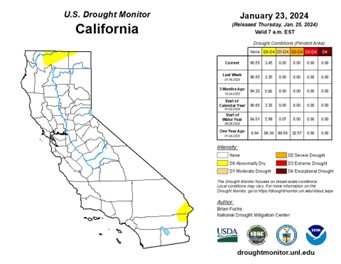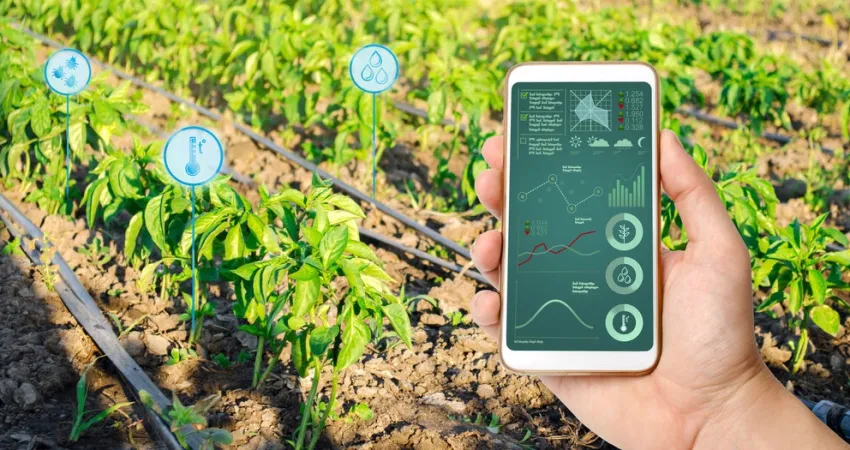The Almond Farmer’s Challenge: Battling the Effects of Drought
Almond farming in California, particularly in the Central Valley, is not just an industry but a cornerstone of the state’s agricultural economy. California produces over 80% of the world’s almonds, making it the largest almond producer globally. However, this feat comes with significant challenges, most notably the region’s susceptibility to drought.
Droughts can devastate almond crops by reducing water availability, stressing trees, and affecting overall yield and quality. Almond trees require consistent water throughout the growing season, particularly during critical periods such

California Drought Map January 2024
as bloom and nut development. When water is scarce due to drought conditions, farmers must rely on groundwater reserves or face the daunting task of prioritizing water allocation among competing crops and agricultural needs.
The recent history of California serves as a stark reminder of drought’s impact. Despite the current reprieve from drought conditions, the state has endured severe drought episodes cyclically. These fluctuations underscore the vulnerability of almond farming and the urgent need for sustainable water management practices.
There is a common misconception that almond farming uses an excessive amount of California’s water. While almonds occupy 13% of the state’s irrigated farmland, they use only 9% of California’s agricultural water, which is less than their proportionate share. Almond trees require the same amount of water as other fruit and nut trees in the region, and the water used also supports the production of valuable by-products like livestock feed and firewood.
Adapting to Climate Oscillations
To comprehend California’s water cycle and its connection to almond farming, one must consider global climate phenomena such as El Niño and La Niña. These oscillations in ocean temperatures in the Equatorial Pacific Ocean influence weather patterns worldwide. As we face these cyclical climate patterns, our innovative water conservation measures are essential in ensuring the resilience and sustainability of our almond farming operations.

Example Of El Nino vs La Nina
- El Niño: Characterized by warmer-than-average sea surface temperatures, El Niño typically brings wetter conditions to California. This surplus of precipitation can replenish reservoirs, support groundwater recharge, and alleviate drought stress temporarily.
- La Niña: Conversely, La Niña involves cooler-than-average sea surface temperatures, often leading to drier weather in California. This exacerbates drought conditions, prolonging water scarcity and increasing the strain on almond farmers and other agricultural sectors.
The transition from El Niño to La Niña or vice versa can significantly impact California’s water resources, affecting not only farmers but also urban water supplies, ecosystems, and wildfire risks. In 2023, California is experiencing a transition from El Niño conditions to La Niña. This shift raises concerns as La Niña conditions typically result in reduced precipitation and potentially more severe drought conditions. Almond farmers and water managers must prepare for possible water shortages and increased irrigation demands, highlighting the critical need for water conservation measures.
Our Commitment to a Sustainable Future
As we commemorate National Drought Conservation Day, let us reflect on the interconnectedness of climate patterns, water availability, and almond farming in California. Droughts are not just environmental phenomena; they are economic and social challenges that require collective action and innovation. By understanding the impact of drought on almond farmers, recognizing the influence of global climate oscillations like El Niño and La Niña, and championing conservation efforts, we can safeguard water resources, support sustainable agriculture, and ensure a resilient future for California and beyond.

Thriving Almond Tree: A Testament to Sustainable Farming
At Maisie Jane’s, we believe that every drop of water saved today contributes to a more secure future for our farms, communities, and ecosystems. Our practices not only ensure the sustainability of our almond orchards but also support vital bee research, promote better foraging and water sources for bees, and enhance the overall health of our farmland. By embracing advanced technology and holistic land management, we are making significant strides in conserving water and promoting environmentally friendly farming techniques. Together, we can achieve a resilient and sustainable future for California’s almond farming industry. Let us embrace the spirit of conservation not just on this day but as an ongoing commitment to preserving our precious water resources for generations to come.

